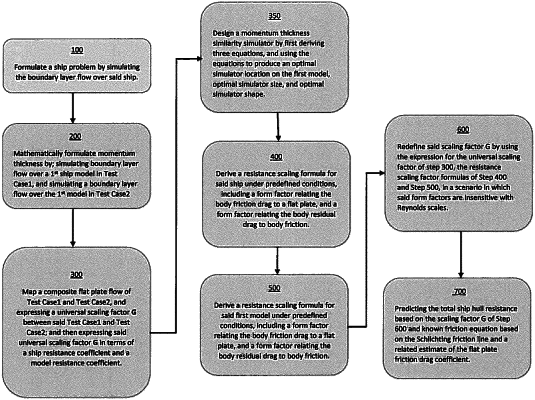| CPC G06F 30/15 (2020.01) [B63B 3/14 (2013.01); G06F 17/13 (2013.01); G06F 30/20 (2020.01)] | 4 Claims |

|
1. A hydrodynamic testing method comprising:
causing a model-scale vessel to move through water, wherein:
said model-scale vessel is characterized by a model-scale momentum thickness when said model-scale vessel moves through water at a selected model-scale vessel speed;
said model-scale momentum thickness relates to a model-scale boundary layer of said model-scale vessel;
said model-scale momentum thickness corresponds to a full-scale momentum thickness;
said full-scale momentum thickness relates to a full-scale boundary layer of a full-scale vessel, wherein:
said full-scale vessel is characterized by said full-scale momentum thickness when said full-scale vessel moves through water at a selected full-scale vessel speed;
said model-scale vessel is characterized by a selected geometry and includes a smooth axisymmetric body and a momentum thickness simulator;
in furtherance of said selected geometry, said momentum thickness simulator is characterized by a selected shape and a selected height;
said providing of said model-scale vessel includes coupling said momentum thickness simulator with said smooth axisymmetric body at a location at a selected distance from said model-scale leading edge;
said model-scale vessel is characterized by a turbulent said model-scale boundary layer between said momentum thickness simulator and said model-scale trailing edge;
measuring a model-scale resistance of said model-scale vessel, wherein said model-scale resistance is associated with said movement of said model-scale vessel through water at said model-scale vessel speed during which time said model-scale vessel is characterized by said model-scale momentum thickness;
determining a full-scale resistance of said full-scale vessel, said determining of said full-scale resistance including using a computer, wherein:
said full-scale resistance is associated with said movement of said full-scale vessel through water at said full-scale vessel speed during which time said full-scale vessel is characterized by said full-scale momentum thickness;
said determining of said full-scale resistance includes performing scaling of said model-scale resistance with respect to said full-scale resistance;
said performance of said scaling includes taking into consideration said movement of said model-scale vessel through water at said model-scale vessel speed during which time said model-scale vessel is characterized by said model-scale momentum thickness;
said performance of said scaling further includes taking into consideration said movement of said full-scale vessel through water at said full-scale vessel speed during which time said full-scale vessel is characterized by said full-scale momentum thickness;
said full-scale resistance is determined directly from said model-scale resistance in the absence of consideration of said full-scale resistance as consisting of frictional said full-scale resistance and residual said full-scale resistance.
|